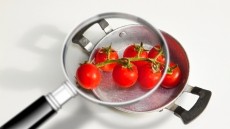Superbugs and plastic pollution: Researchers link microplastics to antimicrobial resistance spread

When plastic – including plastic used in food and beverage packaging – is not disposed of correctly, it can end up leaking into the environment and even into people.
Last year, four high production volume polymers applied in plastic were identified and quantified for the first time in human blood. PET plastic which is used in drink bottles was identified, as was plastic from packaged food and plastic bags.
This is because mismanaged plastics break down into smaller pieces known as microplastics (5 millimetres to 1 micrometre), sub-micron plastics (1 micrometre to 100 nanometres), and nanoplastic particles (less than 100 nanometres).
Some of these particles are thought to be so small they can pass through physiological barriers and enter organisms, making their way into the food system. Indeed, a 2022 study found that nanoplastics can be transferred from contaminated soil to plants. Those plants were fed to insects, who themselves were eaten to fish, which researchers warned presented a potential health risk to humans.
Even more concerning is fresh research out of the College of Agricultural, Consumer and Environmental Sciences (ACES) at the University of Illinois Urbana-Champaign, which suggests micro- and nanoplastics in agricultural soil (like every industry, modern farming relies heavily on plastics) could contribute to antibiotic resistant bacteria – with a ready route into our food supply.
Linking microplastics to antimicrobial resistance
Antimicrobial resistance (AMR) is considered a global threat to human health. It stems from the increased use or misuse of antimicrobial medicines in human and animal healthcare, which has contributed to an increase in the number of disease-causing microbes that are resistant to the antimicrobial medicines used to treat them, like antibiotics.
According to the World Health Organization (WHO), AMR is amongst the top 10 global public health threats facing humanity and is estimated to be associated with close to five million deaths annually.
So how are microplastics and antibiotic resistance linked? According to Jayashree Nath, postdoctoral researchers in the Department of Food Science and Human Nutrition at ACES, plastic itself is not considered very toxic, but it can act as a vector for transmitting pathogenic and antimicrobial resistant bacteria into the food chain.
Being an absorbent material, chemical substances and microscopic organisms can stick to plastic. That means that chemicals that would ordinarily move through soil quickly, whether pesticides or heavy metals, are halted by the presence of plastic particles around which they gather.
At the same time, bacteria and other microorganisms that occur naturally in soil congregate on the stable surfaces of microplastics, forming biofilms. “The slimy nature of biofilm plays a major role in the subsequent attachment and absorption of many other pollutants and pathogenic microbes, thereby becoming a hub or hotspot for gene transfer,” noted the study authors.
Indeed, when bacteria encounter unusual chemical substances in their new home base, they activate stress response genes that help them resist other chemical too, including, sometimes, antibiotics. And those genes can be shared through a process called horizontal gene transfer.
‘Soil is an under-researched area in this field’
Nanoplastics are known to enter bacterial cells, and this presents a different kind of stress. But according to the researchers, that stress can have the same outcome.
“Bacteria have been evolving genetic mechanisms to cope with stress for millions of years. Plastic is a new material bacteria have never seen in nature, so they are now evoking these genetic tool sets to deal with that stress” said co-author Pratik Banerjee. “We have also shown bacteria may become more virulent in the presence of plastics, in addition to becoming more resistant to antimicrobials.”
This area of research is only in its initially phase, and the researchers ‘strongly’ believe that several other important factors may yet to be identified. Gene transfer between bacteria on microplastics has been documented in other environments, particularly water. So far, the phenomenon is only hypothetical in agricultural soil, but that doesn’t mean it’s not happening, FoodNavigator understands.
Both Nath and Banerjee are currently running laboratory studies to document gene transfer. “Soil is an under-researched area in this filed,” said Banerjee. “We have an obligation to understand what’s going on in the soil, because what we suspect and what we fear is that the situation in soil could be even worse than in water.
“One of the technical problems is that soil is a very difficult medium to handle when it comes to fishing out microplastics. Water is so easy because you can simply filter the microplastic out. But we have made some good headway thanks to Jayashree and our collaboration with the Illinois Sustainable Technology Center.”
The researchers stressed the need for deeper insight into micro-nano plastics contamination and agroecosystems as well proper control measures for plastic usage in agriculture.
Source: Pathogens
‘Interaction of Microbes with Microplastics and Nanoplastics in the Agroecosystems – Impact on Antimicrobial Resistance’
Published 29 June 2023
DOI: https://doi.org/10.3390/pathogens12070888
Authors: Jayashree Nath, Jayita De, Shantanu Sur and Pratik Banerjee















